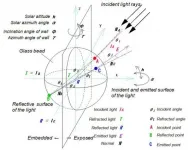(Press-News.org) A new neural network developed by researchers at the University of Eastern Finland and Kuopio University Hospital enables an easy and accurate assessment of sleep apnoea severity in patients with cerebrovascular disease. The assessment is automated and based on a simple nocturnal pulse oximetry, making it possible to easily screen for sleep apnoea in stroke units.
Up to 90% of patients experiencing a stroke have sleep apnoea, according to earlier studies conducted at Kuopio University Hospital. If left untreated, sleep apnoea can reduce the quality of life and rehabilitation of patients with stroke and increase the risk for recurrent cerebrovascular events.
"Although screening of sleep apnoea is recommended for patients with cerebrovascular disease, it is rarely done in stroke units due to complicated measurement devices, time-consuming manual analysis, and high costs," Researcher Akseli Leino from the University of Eastern Finland says.
In the new study, researchers developed a neural network to assess the severity of sleep apnoea in patients with acute stroke and transient ischaemic attack (TIA) by using a simple nocturnal oxygen saturation signal. The apnoea-hypopnea index, which represents the number of apnoea and hypopnea events per hour, is commonly used in the diagnostics of sleep apnoea. When the researchers compared the results of manual scoring and those obtained using the new neural network, the median difference was only 1.45 events per hour. The neural network was also 78% accurate in classifying patients into four different categories on the basis of sleep apnoea severity (no sleep apnoea, mild, moderate, severe). The neural network was able to identify moderate and severe sleep apnoea, both of which require treatment, in patients with acute stroke or TIA with a 96% specificity and a 92% sensitivity.
"The neural network developed in the study enables an easy and cost-effective screening of sleep apnoea in patients with cerebrovascular disease in hospital wards and stroke units. The nocturnal oxygen saturation signal can be recorded with a simple finger pulse oximetry measurement, with no time-consuming manual analysis required," Medical Physicist Katja Myllymaa from Kuopio University Hospital points out.
INFORMATION:
The study was conducted in collaboration between the Department of Clinical Neurophysiology and the Department of Neurology at Kuopio University Hospital, and the Department of Applied Physics at the University of Eastern Finland. The study was funded by the Academy of Finland, Business Finland, Kuopio University Hospital, the Finnish Cultural Foundation, Kuopio Area Respiratory Foundation, the Research Foundation of the Pulmonary Diseases, the Finnish Anti-Tuberculosis Association Foundation, Päivikki & Sakari Sohlberg Foundation, Paulo Foundation, and Tampere Tuberculosis Foundation.
For further information, please contact:
Early Stage Researcher Akseli Leino, MSc (Tech), akseli.leino@uef.fi
Docent, Medical Physicist Katja Myllymaa, PhD, katja.myllymaa@kuh.fi
Research article:
Leino A, Nikkonen S, Kainulainen S, Korkalainen H, Töyräs J, Myllymaa S, Leppänen T, Ylä-Herttuala S, Westeren-Punnonen S, Muraja-Murro A, Jäkälä P, Mervaala E, Myllymaa K. Neural network analysis of nocturnal SpO2 signal enables easy screening of sleep apnea in patients with acute cerebrovascular disease. Sleep Med 2020;79. https://doi.org/10.1016/j.sleep.2020.12.032
An estimated 48 million cases of foodborne illness are contracted in the United States every year, causing about 128,000 hospitalizations and 3,000 deaths, according to the Centers for Disease Control (CDC). In some instances, the source is well known, such as a batch of tainted ground beef that infected 209 people with E. Coli in 2019. But 80 percent of food poisoning cases are of unknown origin, making it impossible to inform consumers of hazardous food items.
David Goldberg, assistant professor of management information systems at San Diego State University, wants to improve the traceability and ...
Overview:
Phycocyanobilin (PCB) is a natural blue chromophore found in cyanobacteria. PCB is expected to be applied as food colorants and pharmaceuticals with anti-inflammatory and antioxidant properties. PCB also functions as the chromophore of photoswitches that control biological functions in synthetic biology. PCB is covalently bound to phycocyanin, a component of photosynthetic antenna protein, and its extraction requires specialized expertise, time-consuming procedures, and/or expensive reagents. A research group led by Assistant Professor Yuu Hirose at Toyohashi University of Technology succeeded in developing a highly efficient and rapid extraction method for PCB by treating cyanobacterial cells with alcohol ...
The use of online messaging and social media apps among Singapore residents has spiked during the COVID-19 pandemic, a Nanyang Technological University, Singapore (NTU Singapore) study has found.
Three in four respondents (75%) said that their use of WhatsApp during the pandemic increased. This was followed by Telegram (60.3%), Facebook (60.2%) and Instagram (59.7%).
Accompanying this spike is videoconferencing fatigue, found the NTU Singapore study, which surveyed 1,606 Singapore residents from 17 to 31 December last year. Nearly one in two Singapore residents (44%) said they felt drained from videoconferencing activities, which ...
Utilizing a newly developed state-of-the-art synchrotron technique, a group of scientists led by Dr. Ho-kwang Mao, Director of HPSTAR, conducted the first-ever high-pressure study of the electronic band and gap information of solid hydrogen up to 90 GPa. Their innovative high pressure inelastic X-ray scattering result serves as a test for direct measurement of the process of hydrogen metallization and opens a possibility to resolve the electronic dispersions of dense hydrogen. This work is published in the recent issue of Physical Review Letters.
The pressure-induced evolution of hydrogen's electronic band from a wide gap insulator to a closed gap metal, or metallic ...
A group of KAIST researchers and collaborators have engineered a tiny brain implant that can be wirelessly recharged from outside the body to control brain circuits for long periods of time without battery replacement. The device is constructed of ultra-soft and bio-compliant polymers to help provide long-term compatibility with tissue. Geared with micrometer-sized LEDs (equivalent to the size of a grain of salt) mounted on ultrathin probes (the thickness of a human hair), it can wirelessly manipulate target neurons in the deep brain using light.
This study, led by Professor Jae-Woong Jeong, is a step forward from the wireless head-mounted ...
The prevalence of inflammatory bowel diseases has significantly increased both in Finland and globally. These disorders cannot be entirely cured. Instead, they are treated with anti-inflammatory drugs and, at times, through surgery.
If conventional drug therapies based on anti-inflammatory drugs are ineffective, the diseases can be treated using infliximab, a biological TNF-α blocker that is administered intravenously. Infliximab is an antibody that prevents TNF-α, a pro-inflammatory factor, from binding with inflammatory cells in the intestine. It is effective in reducing inflammation and improving the patient's condition, while also controlling the disease well.
Although infliximab therapy is often effective, roughly 30-40% of patients either do not respond ...
An international research team succeeded in gaining new insights into the artificially produced superheavy element flerovium, element 114, at the accelerator facilities of the GSI Helmholtzzentrum für Schwerionenforschung in Darmstadt, Germany. Under the leadership of Lund University in Sweden and with significant participation of Johannes Gutenberg University Mainz (JGU) as well as the Helmholtz Institute Mainz (HIM) in Germany and other partners, flerovium was produced and investigated to determine whether it has a closed proton shell. The results suggest that, contrary to expectations, flerovium is not a so-called "magic nucleus". The results were published in ...
Two family members test positive for COVID-19 -- how do we know who infected whom? In a perfect world, network science could provide a probable answer to such questions. It could also tell archaeologists how a shard of Greek pottery came to be found in Egypt, or help evolutionary biologists understand how a long-extinct ancestor metabolized proteins.
As the world is, scientists rarely have the historical data they need to see exactly how nodes in a network became connected. But a new paper published in Physical Review Letters offers hope for reconstructing the missing information, using a new method to evaluate the rules that generate network models.
"Network models are like impressionistic ...
A new paper from UC Santa Cruz researchers, published in END ...
Overview:
Jihui Yuan (Assistant Professor, Department of Architecture and Civil Engineering, Toyohashi University of Technology) proposed a numerical bead model to predict the upward-to-downward reflection ratio of glass bead retro-reflective (RR) material purposed for urban heat island (UHI) mitigation and reducing energy consumption. It revealed that the retro-reflectivity of glass bead RR material gradually increases from morning to noon, at which time it begins to gradually decrease. These results will contribute to existing research on the absorption or reflection of solar radiation to improve urban thermal and lighting ...







